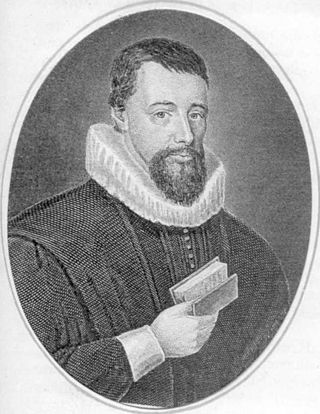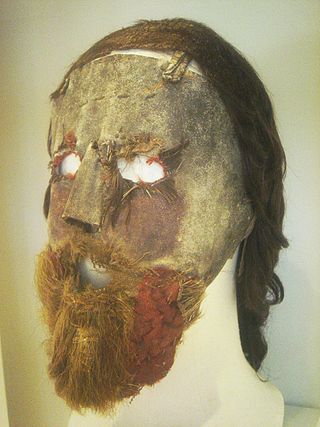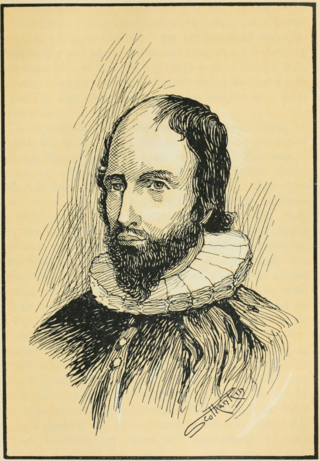Middle English Bible translations (1066-1500) covers the age of Middle English, beginning with the Norman conquest and ending about 1500. Aside from Wycliffe's Bible, this was not a fertile time for Bible translation. English literature was limited because Anglo-Norman French was the preferred language of the elite, and Latin was the preferred literary language in Medieval Western Europe.

Newmilns is a village in the burgh of Newmilns and Greenholm, in East Ayrshire, Scotland. It has a population of 3,057 people and lies on the A71, around seven miles east of Kilmarnock and twenty-five miles southwest of Glasgow. It is situated in a valley through which the River Irvine runs and, with the neighbouring towns of Darvel and Galston, forms an area known as the Upper Irvine Valley.

Wycliffe's Bible or Wycliffite Bibles (WYC) are names given for a sequence of Middle English Bible translations believed to have been made under the direction or instigation of English theologian John Wycliffe of the University of Oxford. They represent the earliest known literal translations of the entire Bible into English. They appeared over a period from approximately 1382 to 1395.

Zachary Boyd (1585–1653) was a Scottish minister and university administrator who wrote many sermons, scriptural versifications and other devotional works. He served as Dean of Faculties, Rector and Vice-Chancellor at the University of Glasgow during the 1630s and 1640s, and bequeathed a generous legacy to the university including his library and large manuscript collection of unpublished sermons and verse.

John Howie was a Scottish biographer. His best known work was Biographia Scoticana, first published in 1775, which is often called The Scots Worthies. It deals with Christians and particularly Presbyterians especially in their strivings with church and civil authorities.

Alexander Peden, also known as "Prophet Peden", was one of the leading figures in the Covenanter movement in Scotland.

The Battle of Drumclog was fought on 1 June 1679, between a group of Covenanters and the forces of John Graham of Claverhouse, at Drumclog, in South Lanarkshire, Scotland.
Dalry is a small town in the Garnock Valley in Ayrshire, Scotland. Drakemyre is a northern suburb.

Clan Nesbitt is a Scottish clan of the Scottish Borders that is recognised by the Lord Lyon King of Arms.

John Nisbet (1627–1685) was a Scottish covenanter who was executed for participating in the insurgency at Bothwell Brig and earlier conflicts and for attending a conventicle. He took an active and prominent part in the struggles, of the Covenanters for civil and religious liberty. He was wounded and left for dead at Pentland in 1666 but lived and fought as a captain at Bothwell Bridge, in 1679. He was subsequently seized and executed as a rebel. He was a descendant of Murdoch Nisbet, a Lollard who translated the Bible into the Scots language.
Barrhill is a village in South Ayrshire, Scotland with a population of approximately 400 in 2001.

William Guthrie (1620–1665) was a Scottish Covenanter minister and author. He was the first minister of Fenwick parish church in Ayrshire, Scotland. He is known primarily for his book on assurance, The Christian's Great Interest.
To date, the Bible has not been completely translated into Lowland Scots. In 1513-39 Murdoch Nisbet, associated with a group of Lollards, wrote a Scots translation of the New Testament, working from John Purvey's Wycliffite Bible. However, this work remained unpublished, in manuscript form, and was known only to his family and Bible scholars. It was published by the Scottish Text Society in 1901–5. The first direct translation of a book of the Bible from one of the original languages, rather than a pre-existing English model was Peter Hately Waddell's The Psalms: frae Hebrew intil Scottis, published in 1871.

The Ecclesiae Regimen, also Remonstrance, xxxvii Conclusiones Lollardorum, or Thirty Seven Articles against Corruptions in the Church, is a church reformation declaration against the Catholic Church of England in the Late Middle Ages. It had no official title given to it when written and the author(s) did not identify themselves in the original manuscript. This public declaration by the English medieval sect called the Lollards was announced to the English parliament at the end of the manifesto Twelve Conclusions of the Lollards published in 1395.

The remains of the old castle of Kersland lie about 1.5 miles to the north-east of the town of Dalry in North Ayrshire, Scotland, in the old Barony of Kersland. The River Garnock lies nearby.

George Scot or Scott of Pitlochie, Fife was a Scottish writer on colonisation in North America.

Robert Garnock was a Scottish covenanter. He was baptised by James Guthrie and like him was hanged in Edinburgh although at a different time and place; Guthrie was executed about 20 years before Garnock.

Rev Archibald Riddell (1635–1708) was a Scots-born 17th-century Presbyterian church minister in Scotland and America. His name is sometimes spelled Riddel. He preached at conventicles in a time when such actions were considered high treason. He was imprisoned on the Bass Rock and was later banished to New Jersey.

John King was an outlawed minister of the Covenant, chaplain at one time to Lord Cardross, but seized by Claverhouse among the insurgents after the affair at Drumclog. King was taken to Edinburgh along with another preacher named John Kid. They were each subjected to torture, condemned to death, and executed. Following his death King's head and limbs were displayed at the Netherbow Port on Edinburgh's Royal Mile beside James Guthrie's skull.

The Castle and Lands of Auchruglen (NS5365436797) was a peel tower in the old district of Kyle held at different times by the Nesbitt and Campbell Clans and located near Newmilns, Parish of Galston, East Ayrshire, Scotland.

















